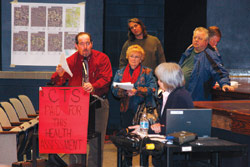It was a tense moment in the T.C. Roberson High School theater on the evening of Jan. 21. Sandy Mort of the state Department of Health and Human Services, the author of a recent study on the health effects of contamination near the former CTS of Asheville site (see sidebar), had just told the audience that a bus stop near the site posed no hazard. For the better part of three hours, the HHS staffer had heard a litany of neighboring residents' tales of personal pain, criticisms of the study and calls to clean up the source of the trichloroethylene contamination.
"Do you have a heart? Do you hear what these people are saying?" one woman shouted.
Holding the microphone close to her mouth, Mort gave a slight sigh and said, "We work with the information we have; that's reality."
Earlier, Mort had presented the study to about 50 people who'd turned up despite the rainy night. And though Buncombe County Health Director Gibbie Harris had asked the audience to stay calm and hold their questions till the end of Mort's presentation, they peppered the speaker with questions and pointed comments throughout the evening. The study, noted Mort, does recommend that wells in the ground-water path be tested and that children not be allowed to play near contaminated streams to the east of the Mills Gap Road site.
But resident Tate MacQueen critiqued the study's methods, saying it should have looked for other possible contaminants such as benzene and tested an area based on ground-water pathways instead of a fixed one-mile radius around the abandoned factory site.
"You appear to have cherry-picked your information," said MacQueen. "There are 397 wells within one mile of the site; [the EPA and state officials] have known about this since 1991. It has always been an imminent threat; it continues to be an imminent threat."
"We looked at how and whether people could come into contact with the contamination," Mort replied. "We looked at hundreds and hundreds of samples. If you have more information, provide it to us and we'll add it to the report. We need the hard data of what people can come into contact with."
Residents repeatedly questioned the study's finding that although there were 64 cases in the study area of types of cancer that could be related to TCE exposure, there was no elevated cancer rate. Mort acknowledged that the study's methods do have limitations but added that her agency would continue to update its studies.
Residents, however, countered with tales of cancer and maladies that they believe are linked to the tainted ground water they unknowingly consumed for many years. Although the first EPA tests were conducted in 1991, the first wells weren't capped until 1999.
"We've had a lot of medical problems in our family," said Becky Robinson, whose home was among the first to be put on city water. "We have had no medical recommendations, no guidance, nothing. We had to get our own medical testing. My two grandchildren's immune systems came back compromised. Nothing has been done; nobody has contacted us. My daughter's had lots of medical problems. Her liver started failing, she had a total hysterectomy at 23, seizures, multiple knee operations for cysts. We drank the water for nine years; we fixed our children's bottles with this water. All of them have health problems."
Mort said she thought public-health professionals had been in touch, but Dot Rice, whose well was also capped in 1999, said she hadn't heard from any public doctors until last week.
"We've got staff that can talk to your physicians," said Dr. Doug Campbell, who heads the state agency's Occupational and Environmental Epidemiology Branch.
"Great — what about my medical bills?" asked Robinson.
"Well, we cannot offer that," responded Campbell.
"CTS, the EPA, someone should have to pay for it," she shot back. "We can't afford all these expensive tests."
Resident Aaron Penland cited multiple cases of cancer and other medical problems in his family.
"I've watched family members die from cancer, from tumors; you can't tell me it's not related," he said, terming the cancer assessment "a load of crap" and brandishing a sign declaring "CTS paid for this health assessment." Some of the test samples were collected by a firm hired by the company as part of an agreement with the Environmental Protection Agency.
"We've never even talked to anyone from CTS," Mort replied, noting that HHS had verified all the results and used chemical samples from several different agencies.
Resident Mike Grupy said: "It appears the strategy is just to monitor this and see where it goes. What I don't see on here is a recommendation that says, 'Let's get rid of the toxic chemicals.' Why isn't that in here?"
"We haven't identified an imminent hazard," said Mort as the room burst into laughter. "We've reviewed past and current contaminant information; we've identified people exposed to it who have experienced harm."
The EPA and the state Department of Environment and Natural Resources are responsible for cleanup, Mort clarified later. "You need to take your concerns to them," she said, provoking shouts of "They don't listen!"




An alert for Margaret Williams here:
http://tiny.cc/KEhjr